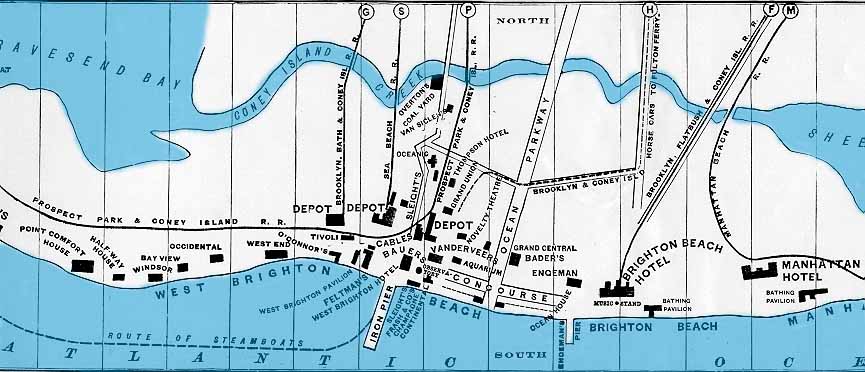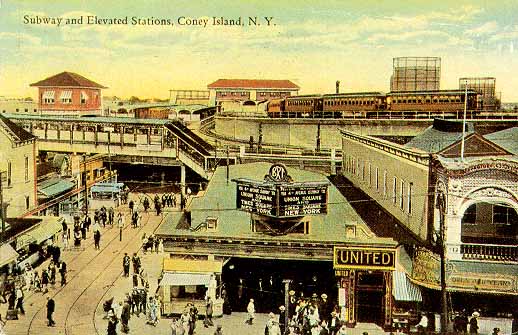Coney Island - Development of Rail & Steamboat Lines to the resort
The material is copyrighted © 1998 by Jeffrey Stanton.
Revised June 2, 1998
Development of Rail and Steamboat Lines to Coney Island
The development of Coney Island's tourist facilities went hand
in hand with the development of transportation routes to the increasingly
popular seaside resort. As transportation to the resort became both easier,
faster and cheaper, tourist facilities were built for the increasing numbers of tourists.
During the early 19th century there was considerable discussion
among the community of building a shell road across the creek to the
nearby beach, since the only existing approach involved crossing the
creek at low tide. Nothing occurred until 1823 when Supervisor Terhune
and others formed the Coney Island Road and Bridge Company as a
private enterprise. They sought funding through a stock issue of 300
shares at $20 / share. The shares were purchased quickly and in 1829
the company built the Shell Road across the creek that separated Coney
Island from the mainland. They also built a hotel called the Coney
Island House which marked the beginning of summer resort business.
Additional tourist development began in 1846 at the far westerly
point of the beach that was later to be known as Norton's Point. Two
New Yorkers, Eddy and Hart, built a pavilion (circular wooden platform
covered by a tent) there. The following year a little side-wheeler
steamer on an irregular schedule began to bring visitors from Manhattan
to a small pier that jutted out into Gravesend Bay. The boat trip, much
faster than the half day ferry and stagecoach route, cost only fifty
cents and required a mere two hour sail down the bay.
The first railroad of any kind to reach Coney Island, actually cars pulled by horses, reached Coney Island in 1860. The terminal was at Van Sicklen's, which at the time was near the beach. However, as the sandbar that protected West Brighton filled in and the beach widened, the present day location of the terminal is far inland.
The Brooklyn, Bath and Coney Island Railroad initially ran to Bath Beach
(where 18th Avenue meets the shore of the Lower Bay, north of Coney Island)
in 1864. The line, which ran from 25th and 5th Avenue in Brooklyn, where
it connected to horsecars, was extended to Coney Island in 1867. The BB&CI
Railroad was a steam railroad and its tracks were laid along a turnpike
road (now New Utrecht Avenue). After C. Godfrey Gunther acquired it, it
was called the Gunther Road. By the mid-1880's the line was owned by the
Brooklyn, Bath and West End Railroad, and for short called the West End
Line. It terminated at the Tivoli Hotel in West Brighton and was located
just west of the Elephant Hotel. It eventually became the West End Terminal
In 1876 it became much easier to reach Coney Island by road. The
Ocean Parkway, a seventy feet wide roadway landscaped with trees and
shrubbery was built from Brooklyn's Prospect Park to the ocean. It was
nearly straight and was flanked by two gravel roads each twenty five
feet wide, perfect for racing surreys.
During the next three years, business men, notably William
Engeman who acquired the title to Brighton Beach, and August Corbin, a
rich banker who acquired title to Manhattan Beach, decided to develop
their respective property. Corbin was a wall street investor and railroad tycoon who
saw potential profits by building two large luxury seaside hotels and a
railroad to bring in customers. His New York and Manhattan Beach
Railway brought the shore within an hour of uptown New York.
Corbin's Manhattan Beach Hotel was built on the far eastern shore
of Coney Island. It was considered the most elegant and fashionable
hotel in the United States. It featured 258 lavish rooms, restaurants,
ballroom and shops. When Ulysses S. Grant delivered the dedication
speech for the hotel's grand opening on July 4, 1877 the event and the
free fireworks show drew such huge crowds that it overwhelmed Corbin's
railroad.
The railroad, which offered direct service with Manhattan, was narrow gauge at first and had two terminals: Bay Ridge with its steamers to Lower Manhattan on the Hudson side, and at Greenpoint. After it was incorporated as part of the Long Island Railroad in 1882, it was standard gauged and was routed to Long Island City instead of Greenpoint within a year or so. However, it continued to run to Greenpoint until about 1900.
The second resort that came into existence about the same time was
William A. Engeman's Brighton Beach, located west of Manhattan Beach.
Engeman had made his fortune selling more than a million horses and
mules to the government during the Civil War. But to put together the
land deal to build his magnificent Brighton Beach Hotel, required
several years of patience and craft on his part. Stillwell, the town's surveyor, acted as Engeman's purchasing agent, no doubt at a
handsome profit, with Engeman's name kept secret until all the lots
had been purchased. He also obliged by including some of the town's
common lands in his map of what Engeman actually owned, enabling
Engeman to secure leases on those lands at trifling sums. Best of all,
Engeman was able at a cost of only $20,000, to take possession of
several hundred acres of prime ocean-front real estate long before he
had actually purchased any part of it.
Engeman constructed his Brighton Beach Hotel in time for the 1878
season. This vast wooden hotel, 460 x 210 feet and several stories
high, with accommodations for nearly 5000, could also feed 20,000
people per day. He also constructed an Iron Pier nearby and the 400
foot wide, two story Brighton Beach Pavilion. His resort was connected
to New York by railroad and was frequented by the upper middle class
rather than the wealthy because its location in Brighton was too close
to Coney Island's seedier section immediately west of it.
The third and final big-time developer was Andrew R. Culver who
ran a steam line to West Brighton shortly before Corbin and Engeman
got their railroads started. His Prospect Park & Coney Island Railroad,
called the Culver Line, terminated in 1875 at a spacious terminal on
the ornamental Culver Plaza along Surf Avenue. It offered regular and
speedy service to Coney Island for a 35 cent fare. However, it irked
Gravesend's 2000 residents because Culver commandeered Gravesend
Avenue, their original village road and its new $80,000 extension
towards Brooklyn, to lay his tracks.
Opposite the station stood the 300 feet tall Iron Tower, a
structure with steam elevators that wisked visitors to the top for a
high view of Coney Island. Culver had purchased it from the 1876
Philadelphia Exposition. A Camera Obscura, which showed a panoramic
view through a combination of lens and mirrors, also from the fair was
installed nearby.
The Iron Pier Company owned by Buel T. Hitchcock, had leased a lot
nearly opposite Culver Plaza. They built the New Iron Pier there in
1880, about 350 feet east of the Old Iron Pier. The company owned a
fleet of side-wheeler steamships that brought passengers from Manhattan
at twenty minute intervals during the summer tourist season.
The final syndicate to provide rail transportation to the island in 1879 built
their New York and Sea Beach Railroad that terminated at their Sea
Beach Palace. Their enormous combination terminal, restaurant and hotel that was moved from the 1876 World's Fair at Philadelphia, was located on Surf Avenue several blocks west of Culver Plaza. It boasted that it could accommodate 10,000 guests overnight and serve 15,000 diners at one sitting. Service began on July 18, 1877 and offered service between Coney Island and the 64th Street Pier and reached the Sea Beach depot in 1879. Their Bay Ridge dock was right next to Manhattan Beach's. Since they were the upstart railroad, they offered lower fares.
The Brooklyn, Flatbush, and Coney Island Railroad between Prospect Park and the Brighton Beach Hotel began service on July 2, 1878. The steam railroad was extended on August 19, 1878 to Atlantic Avenue and Franklin Street where it connected to the Long Island Railroad's mainline. However, the LIRR which owned the competing Manhattan Beach Railroad, terminated the trackage right agreement in December 1883. After losing its connection, the reorganized Brighton Beach Railroad began negotiations with the Kings County Elevated Company to route its trains downtown via the Fulton Street El. The El had been opened in 1888, and even then it didn't connect until the railroad was extended north from Bedford station (south side of Atlantic Avenue) to Fulton Street in 1896. The two companies felt that they could beat out their competition with through service to Coney Island. Service began in 1896 and shortly afterwards the Kings County El took control of the Brighton Line. The line was electrified and in 1899 it provided through trains to Park Row, and Manhattan via the Brooklyn Bridge.
There were no east-west transportation at Coney Island, or even a street
until about 1890. You were supposed to use the railroad or ship that went
to the section of Coney Island that you wanted to patronize. Since many
of the railroads owned land on Coney Island, they wanted customers to use
their amusements, restaurants, hotels and bathing pavilions. Profit wasn't
so much in transporting tourists to Coney Island, but in the money they
spent while on excursion or extended vacation.
|


